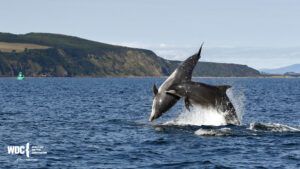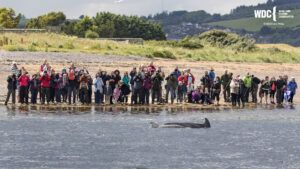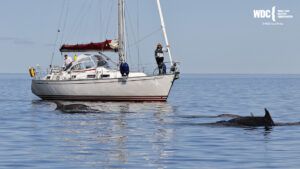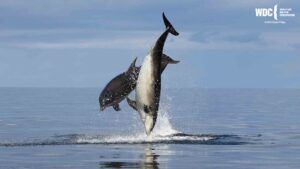Guest blogger Sarah Dolman, Policy Manager at Whale and Dolphin Conservation, and Save Scottish Seas campaign member takes a look at how Scotland’s incredible bottlenose dolphins are faring in our ever busier seas.
Scotland is lucky enough to have two populations of bottlenose dolphins. There are almost 200 dolphins in the east coast population, centred around the Moray Firth. These dolphins have been protected by one of the UK’s longest designated sites, a European Special Area of Conservation (SAC) that has been in place since October 1996 – more than 20 years!
The west coast population consists of about 45 animals, including 12 or 15 that are thought to reside entirely within the Sound of Barra, but they currently receive no site based protection. However all cetacean are offered ‘strict protection’ wherever they are in European waters, and bottlenose dolphins have been identified by Scottish Natural Heritage as a Priority Marine Feature (PMF), which can mean more site-based protection as part of the Marine Protected Area network.
At the time of designation, the bottlenose dolphin population in the Moray Firth was largely contained within the SAC boundary and was reported to be unfavourable (recovering). In the more recent review in 2012, the proportion of the population that used the SAC between 1990 and 2010 had declined, most probably due to an overall increase in population size rather than dolphins leaving the SAC. The population was reported to be stable or increasing, containing about 198 dolphins. It’s difficult to tell whether this increase is directly related to the designation, the management scheme that is in place for the SAC or subsequent management measures, but certainly funding for population monitoring has been at least in part available because of the SAC. In the last decade or two, the dolphins have extended their range, so that some of the population continues to be found within, and now ranges along, the coastal waters of Aberdeenshire as well as across into the waters of north eastern England. The reasons for this range expansion remain unknown. However, the protective requirements of the Habitats Directive mean that SAC protection follows the individual dolphins outside of the SAC boundary, resulting in a higher level of environmental assessment wherever the dolphins are, within or outside of the SAC. This would appear to be a holistic and forward looking approach, as well as being novel, enabling assessment of multiple pressures by relevant authorities wherever they occur.
Moray Firth SAC
The Moray Firth is a busy place and since its designation, the population of bottlenose dolphins have faced changing pressures in their habitat. In recent decades, oil and gas exploration has introduced seismic surveys in the northern North Sea, including within the Firth, which has resulted in impacts. The Ministry of Defence (MOD) conducts military exercises in the region, including live firing and active sonar use. Shipping is increasing and this, alongside dredging activities, has been shown to impact the dolphins. The management of fisheries within SACs is currently under consideration in Scottish government, although this has not focused on marine mammals to date. The designation brings with it an additional level of environmental assessment that has been effective at assessing potential impacts, and in some cases requiring additional mitigation and / or monitoring (including for military exercises, oil and gas exploration). This is perhaps the most significant positive result of the designation.
Whilst any impacts associated with these sectors is incidental, there is also an expanding commercial marine wildlife watching industry in the Moray Firth that spends the summer season seeking out and interacting with the dolphins. This sector is thought to be at capacity within the SAC. Short term changes in the breathing behaviour of the resident dolphins, as a result of boat based dolphin watching, may have longer term consequences for individual dolphins and the whole population.
Visitors that come to see the dolphin population contribute more than £4 million to the economy and have resulted in this active seasonal commercial boat-based industry, as well providing a great opportunity for land-based watching and monitoring. Undoubtedly designation as an SAC has led to opportunities for increasing the profile of the site and the enjoyment of countless tourists.
You might be lucky enough to see the dolphins from land anywhere along the Moray Firth coastline – including at the WDC Scottish Dolphin Centre in Spey Bay. If you chose to go and see the dolphins at sea on a wildlife watching boat, please choose a WiSe accredited operator, these operators are trained in good behaviour around marine wildlife, minimising the chances of disturbance.
Looking to the future
In future years the dolphins will be subject to increasing ship traffic and construction noise associated with pile driving and expanding ports to accommodate a developing offshore wind industry. A number of offshore wind farms have been consented within the range of the dolphins in the last few years and construction was due to begin this summer. Pile driving in particular will continue for many years in the offshore waters, largely outside of the dolphins’ core habitat, but within their range of hearing, with unknown consequences. Most recently, the possibility of ship to ship oil transfers have raised their ugly head.
Although we are still some way from understanding cumulative impacts of all these pressures faced by this dolphin population in their day to day lives, this SAC designation has enabled a focused approach on the management of some activities that may cause pressures that result in significant effects and subsequent population impacts. To this end, the designation has also enabled development of tools to allow better assessment of pressures. One such tool under development is interim population consequences of disturbance (PCOD). A practical example of its application can be found in the assessment of potential impacts of the development and expansion of a number of ports and harbours associated with the development of the wind farms, alongside the existing commercial dolphin watching industry on the dolphin population.
It is the existing baseline monitoring (that is a requirement of SAC designation) that has enabled a quantitative assessment of impacts. Such analysis and assessment is unlikely to be possible for less studied species and shows the value of long-term monitoring as well as robust management.
Management Scheme: http://www.morayfirth-partnership.org/assets/files/SAC%20REV%202/MF-SAC-MS%26AP-Rev-2-Second-Interim-Review-2011-amended-2012.pdf
Some useful references
Cheney, B., Corkrey, R., Quick, N.J., Janik, V.M., Islas-Villanueva, V., Hammond, P.S. and Thompson, P.M. 2012 Site Condition Monitoring of bottlenose dolphins within the Moray
Firth Special Area of Conservation: 2008 – 2010. Scottish Natural Heritage Commissioned
Report No.512.
Davies, B., Pita, C., Lusseau, D. and Hunter, C. 2010. The Value of Tourism Expenditure related to the East of Scotland Bottlenose Dolphin Population. An Aberdeen Centre for Environmental Sustainability report to the Moray Firth Partnership.
Hastie, G.D., Wilson, B., Tufft, L.H. & Thompson, P.M. (2003) Bottlenose dolphins increase breathing synchrony in response to boat traffic. Marine Mammal Science, 19(1): 74-84.
Lusseau, D. 2013. The cumulative effects of development at three ports in the Moray Firth on the bottlenose dolphin interest of the special area of conservation. A report to Marine Scotland.
Merchant, N.D., Pirotta, E., Barton, T.R. & Thompson, P.M. (2014) Monitoring ship noise to assess the impact of coastal developments on marine mammals. Marine Pollution Bulletin, 78: 85-89.
Pirotta, E., Brookes, K.L., Graham, I.M. and Thompson, P.M. 2014. Variation in harbour porpoise activity in response to seismic survey noise. Biology Letters, 10: 20131090
Pirotta, E., Laesser, B.E., Hardaker, A., Riddoch, N., Marcoux, M. and Lusseau, D. 2013. Dredging displaces bottlenose dolphins from an urbanised foraging patch. Mar Poll Bull, 396-402.
Thompson, P.M., Corkrey, R., Lusseau, D., Lusseau, S.M., Quick, N., Durban, J.W., Parsons, K.M. and Hammond, P.S. 2006. An assessment of the current condition of the Moray Firth bottlenose dolphin population. Scottish Natural Heritage Commissioned Report No. 175 (ROAME No. F02AC409).
Thompson, P. M, Lusseau, D, Corkrey, R. and Hammond, P. S. 2004. Moray Firth bottlenose dolphin monitoring strategy options. Scottish Natural Heritage Commissioned Report No. 079 (ROAME No. F02AA409).
Weir C.R., Canning S., Hepworth K., Sim I. and Stockin K.A. 2008. A long-term opportunistic photo-identification study of bottlenose dolphins (Tursiops truncatus) off Aberdeen, United Kingdom: Conservation value and limitations. Aquatic Mammals 34, 436-447.




